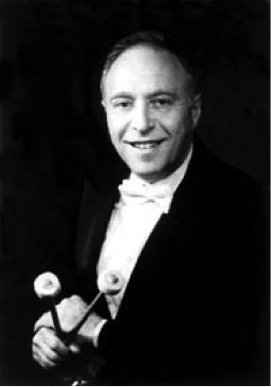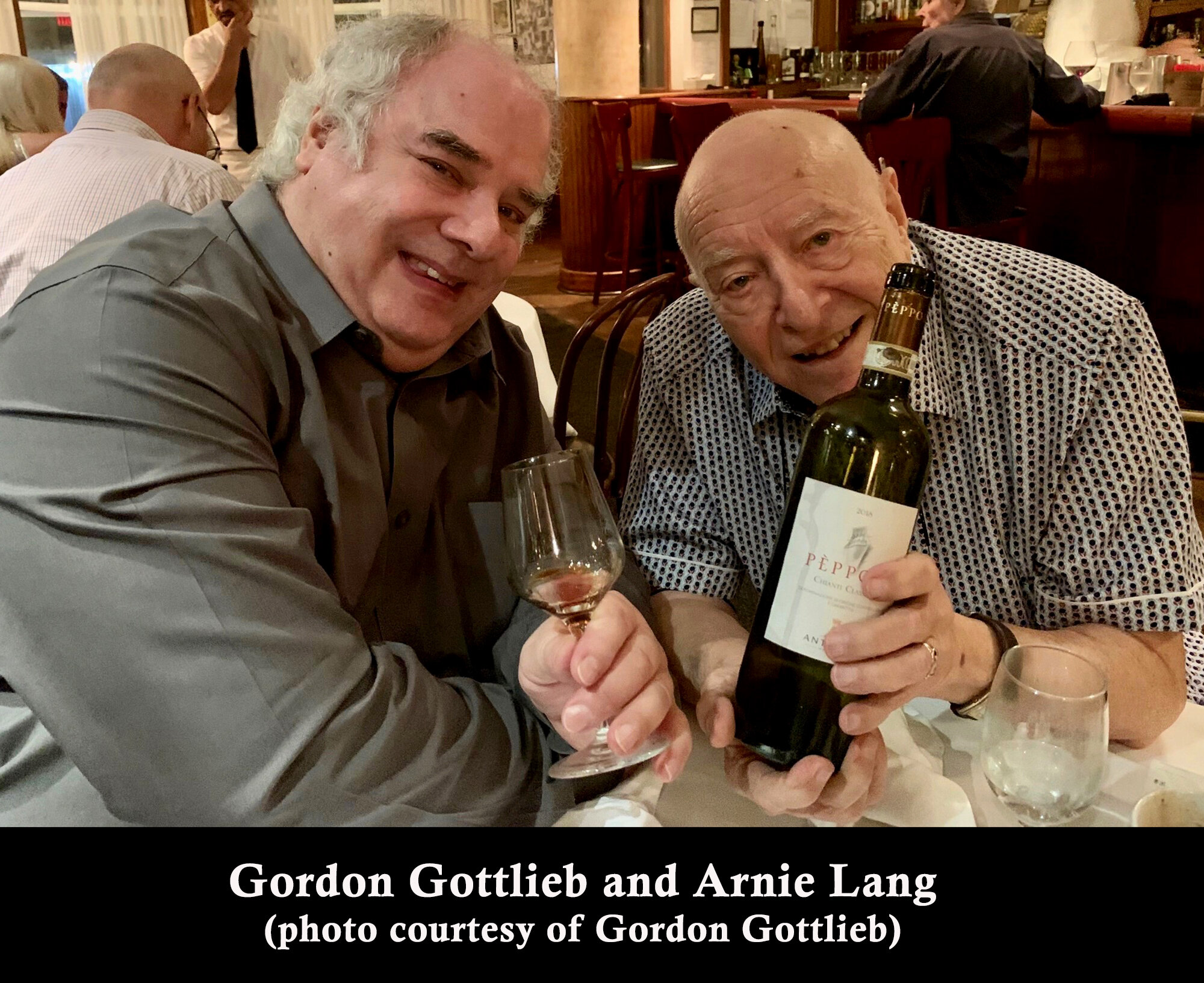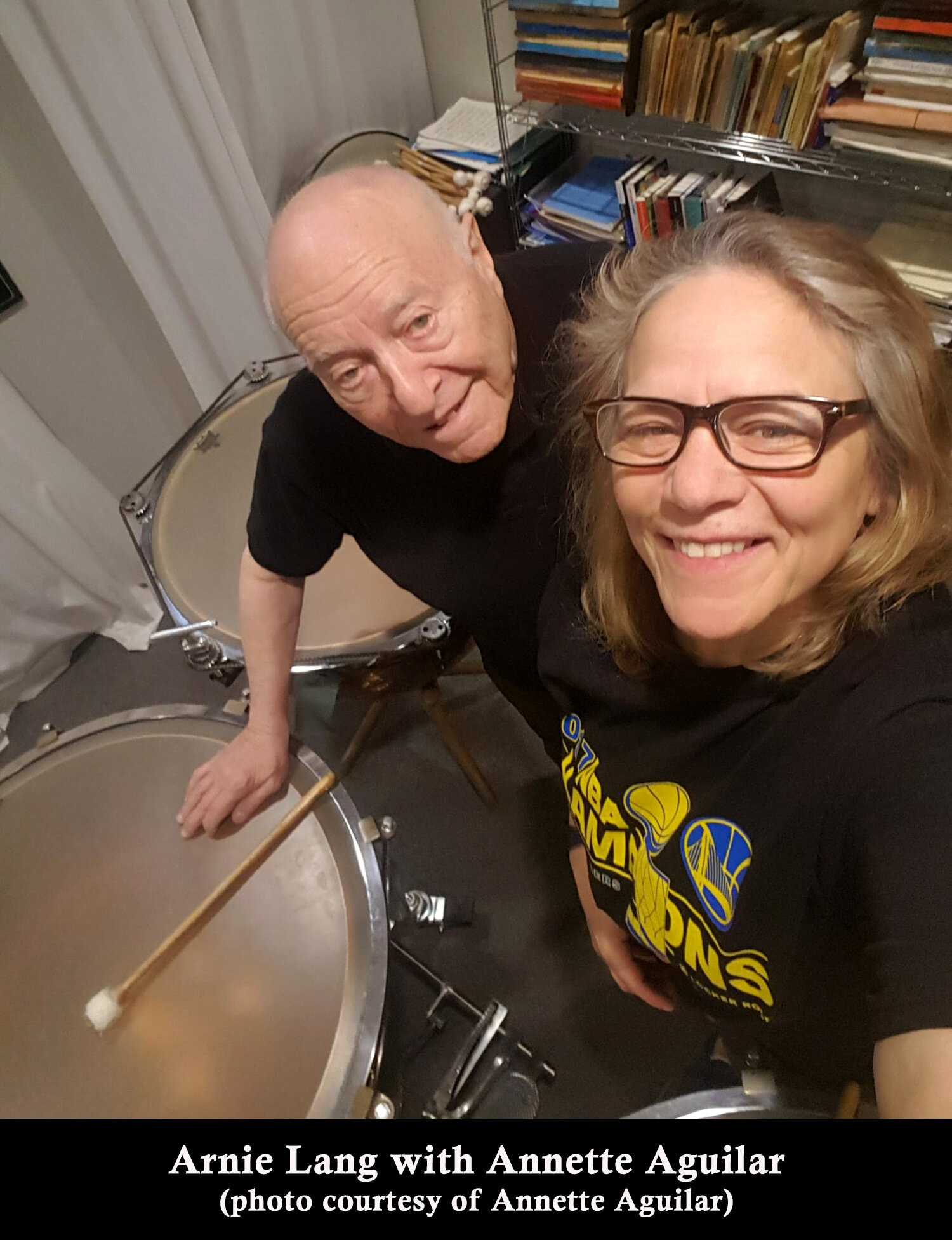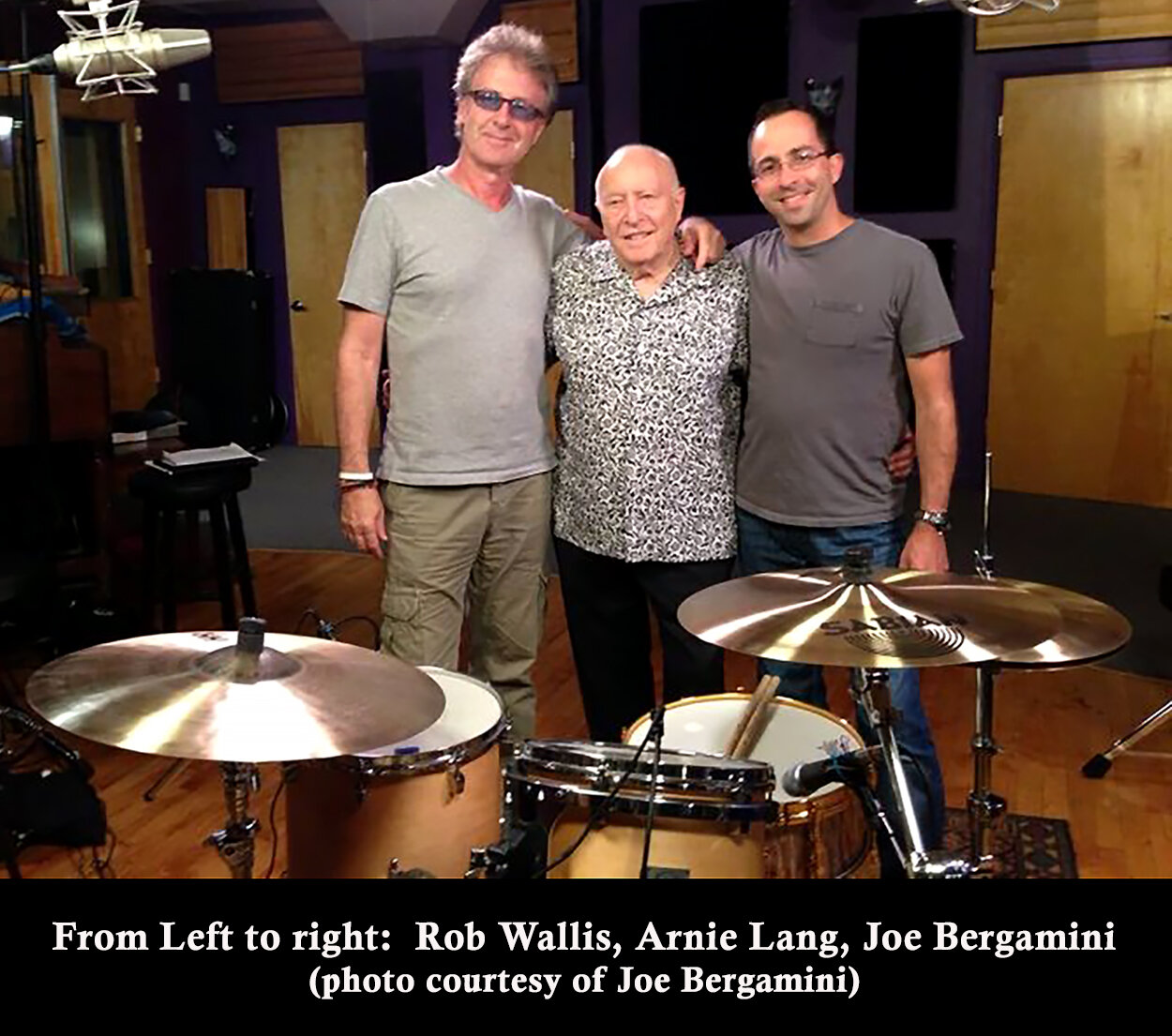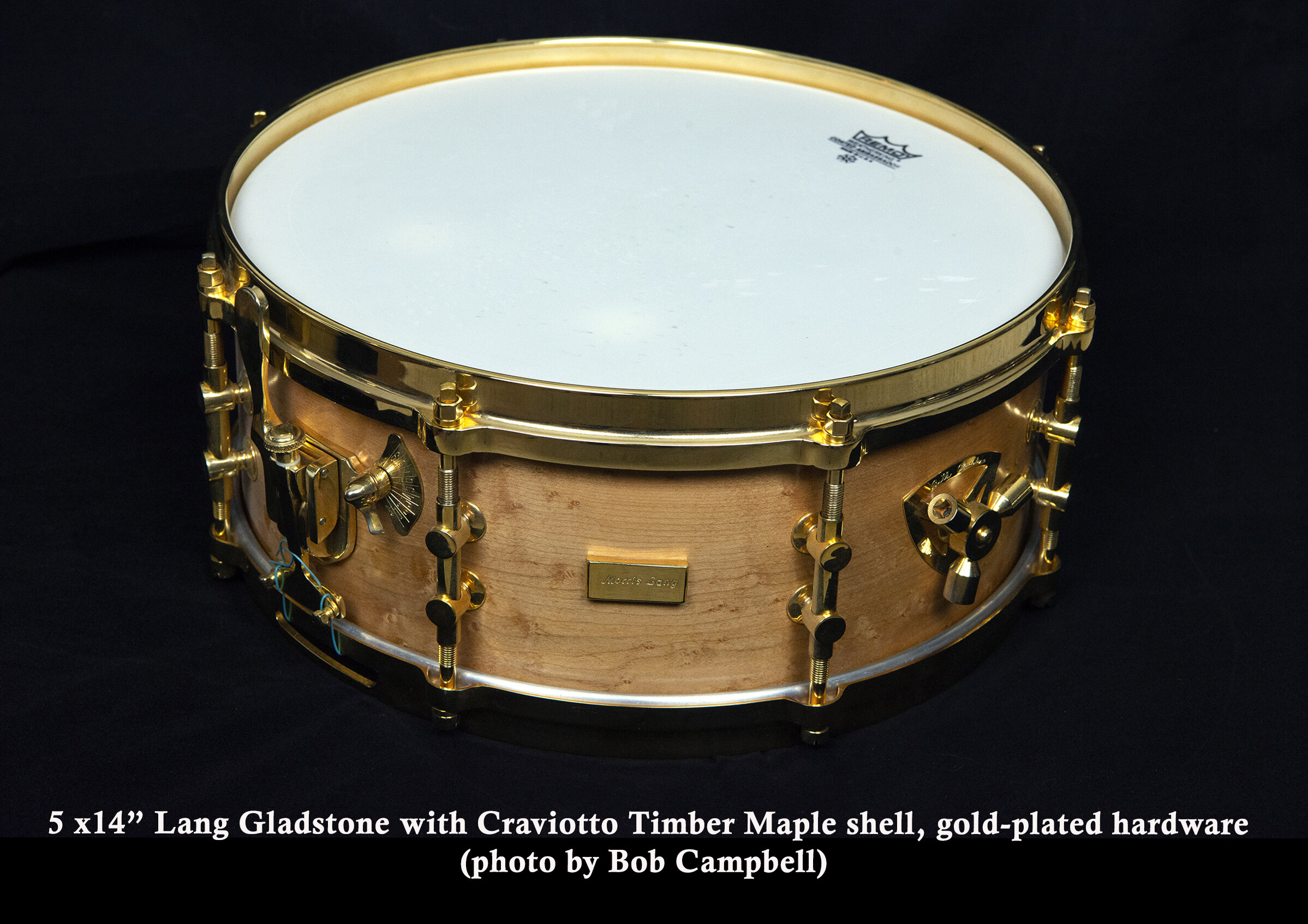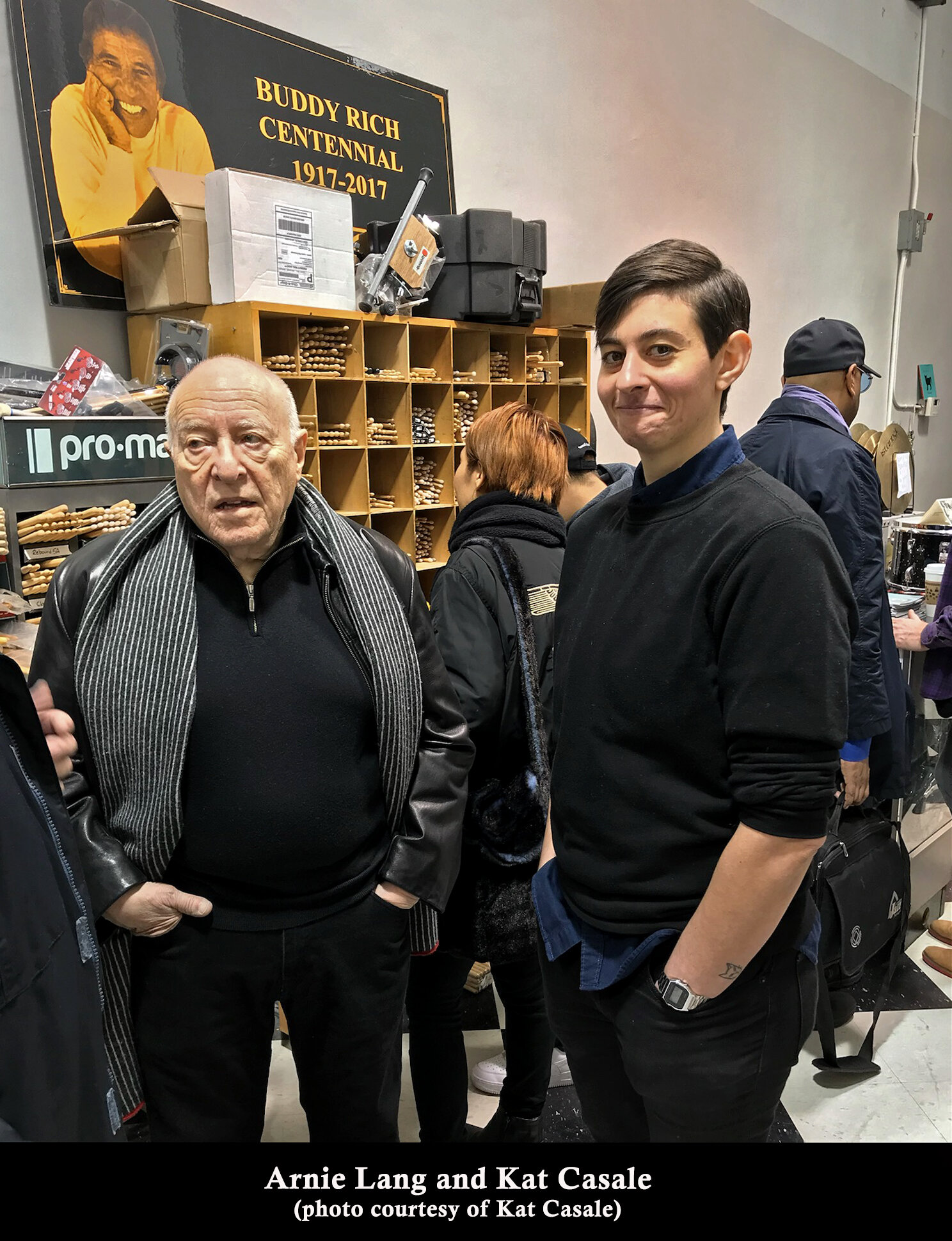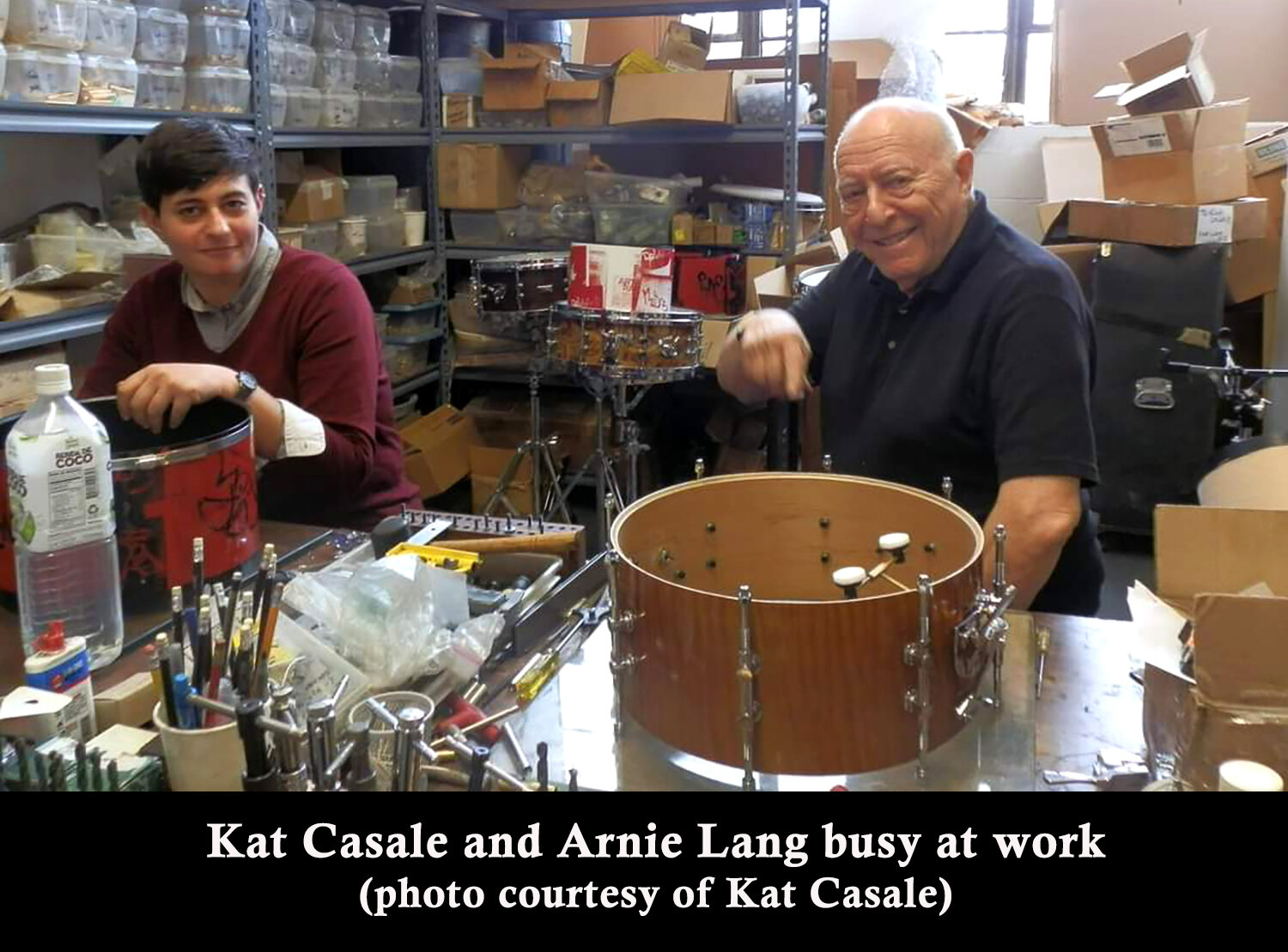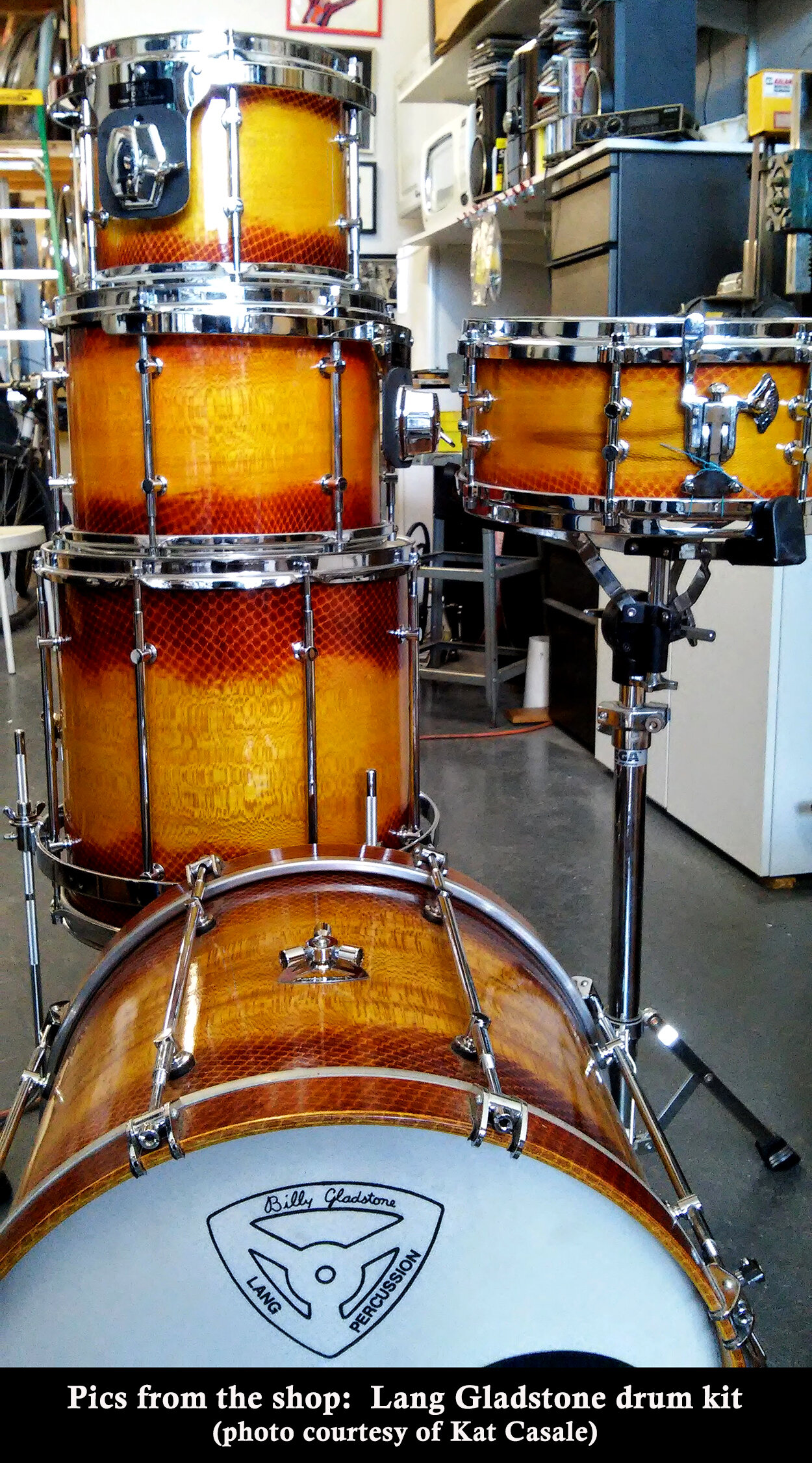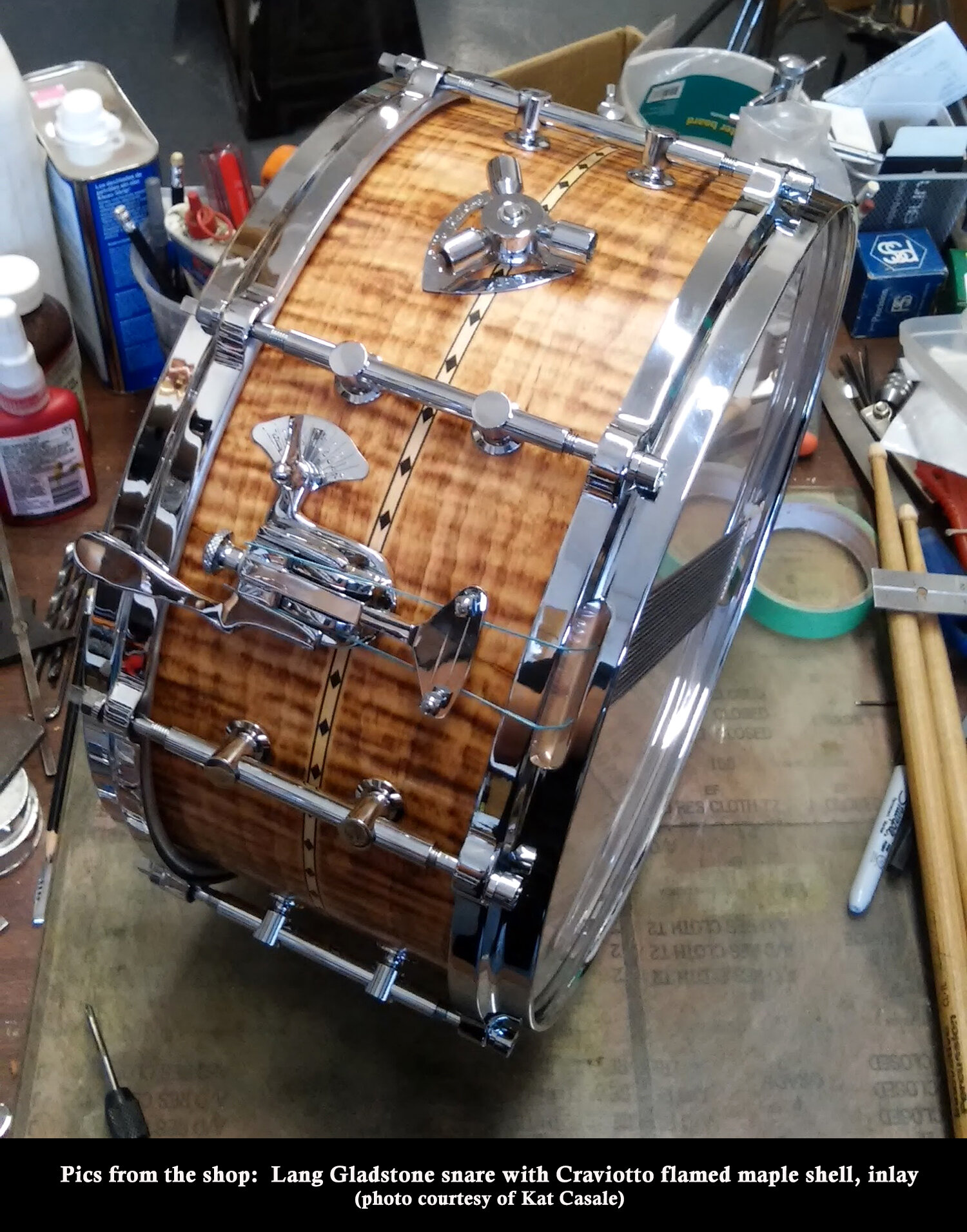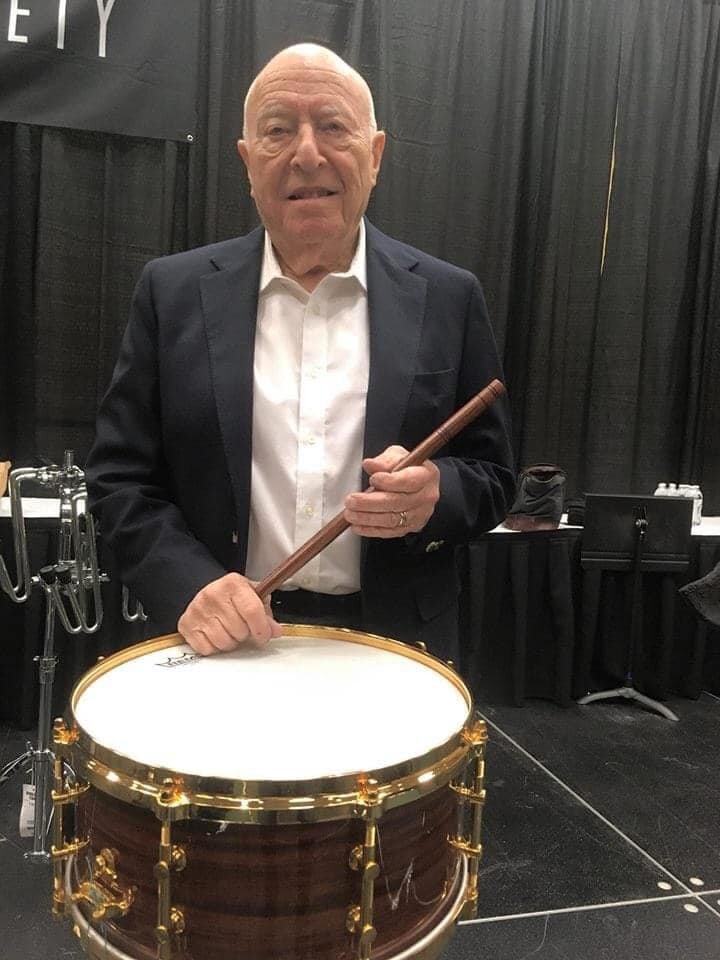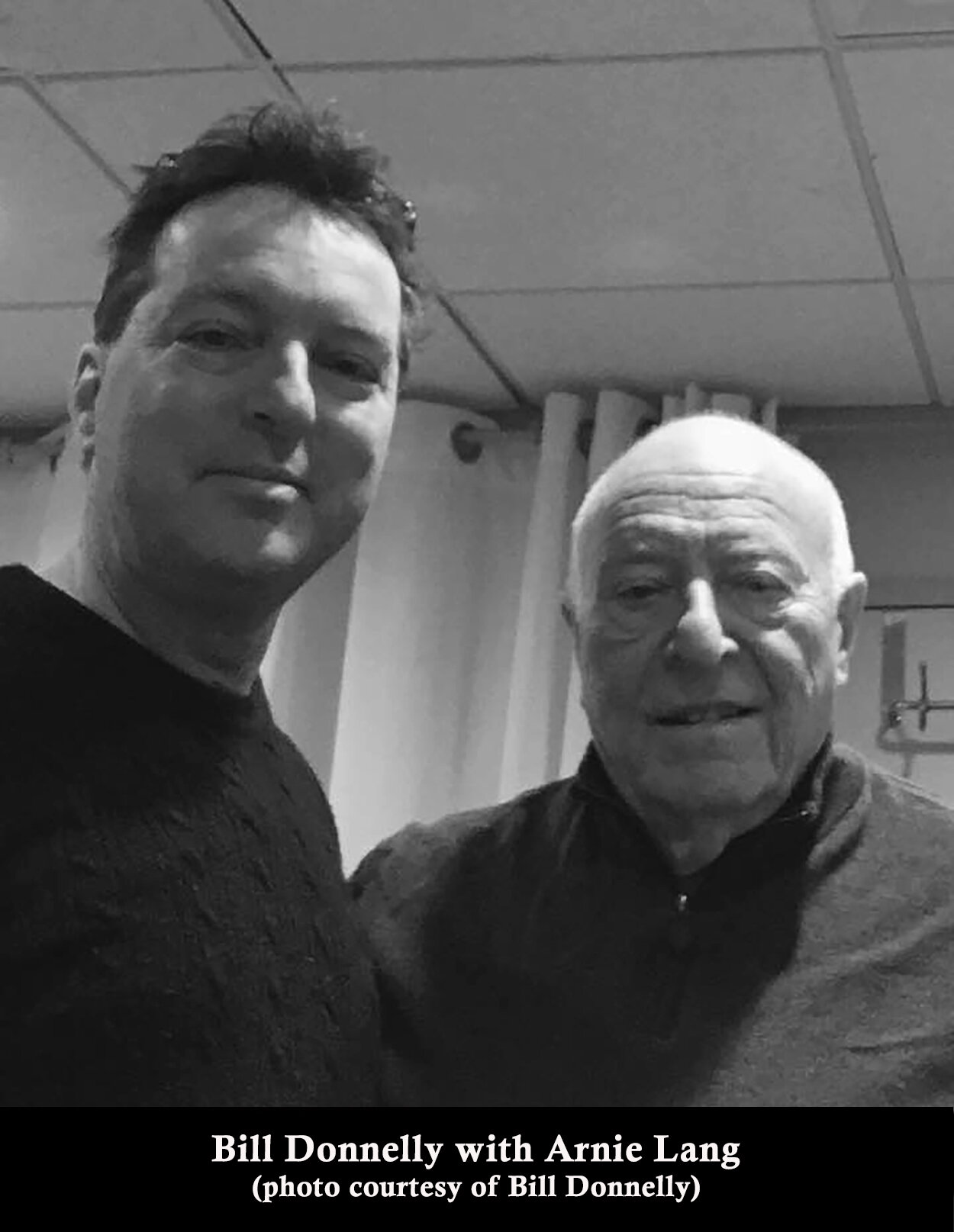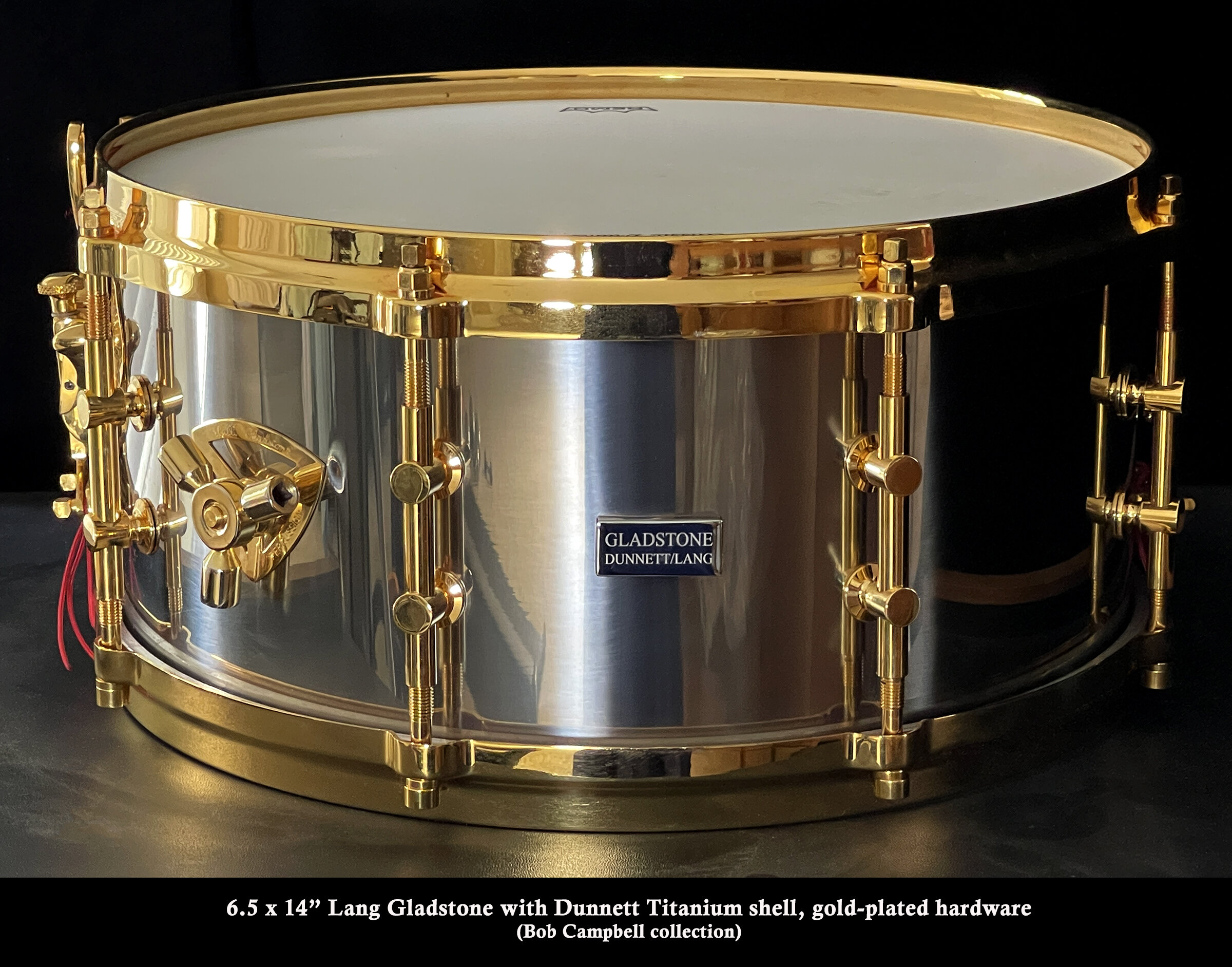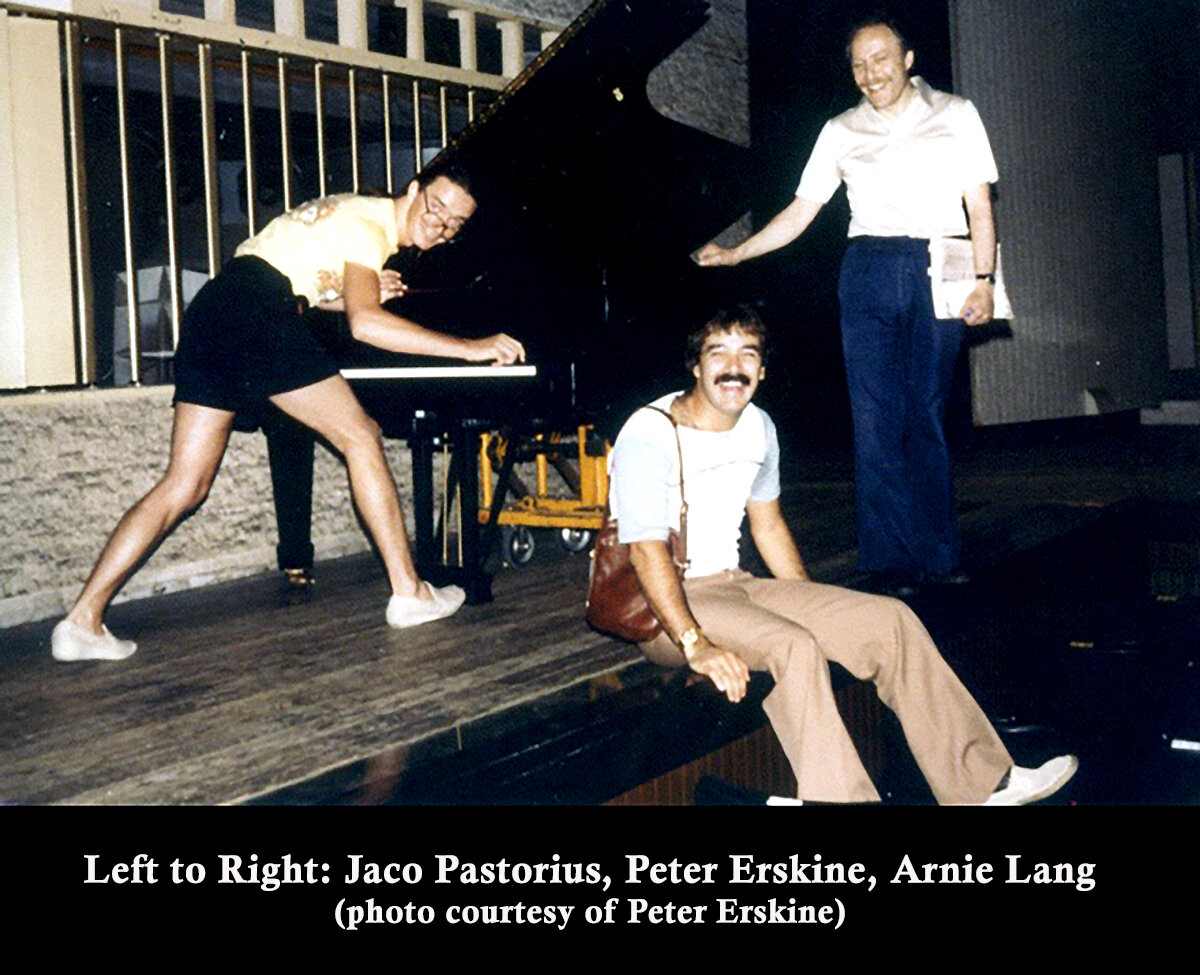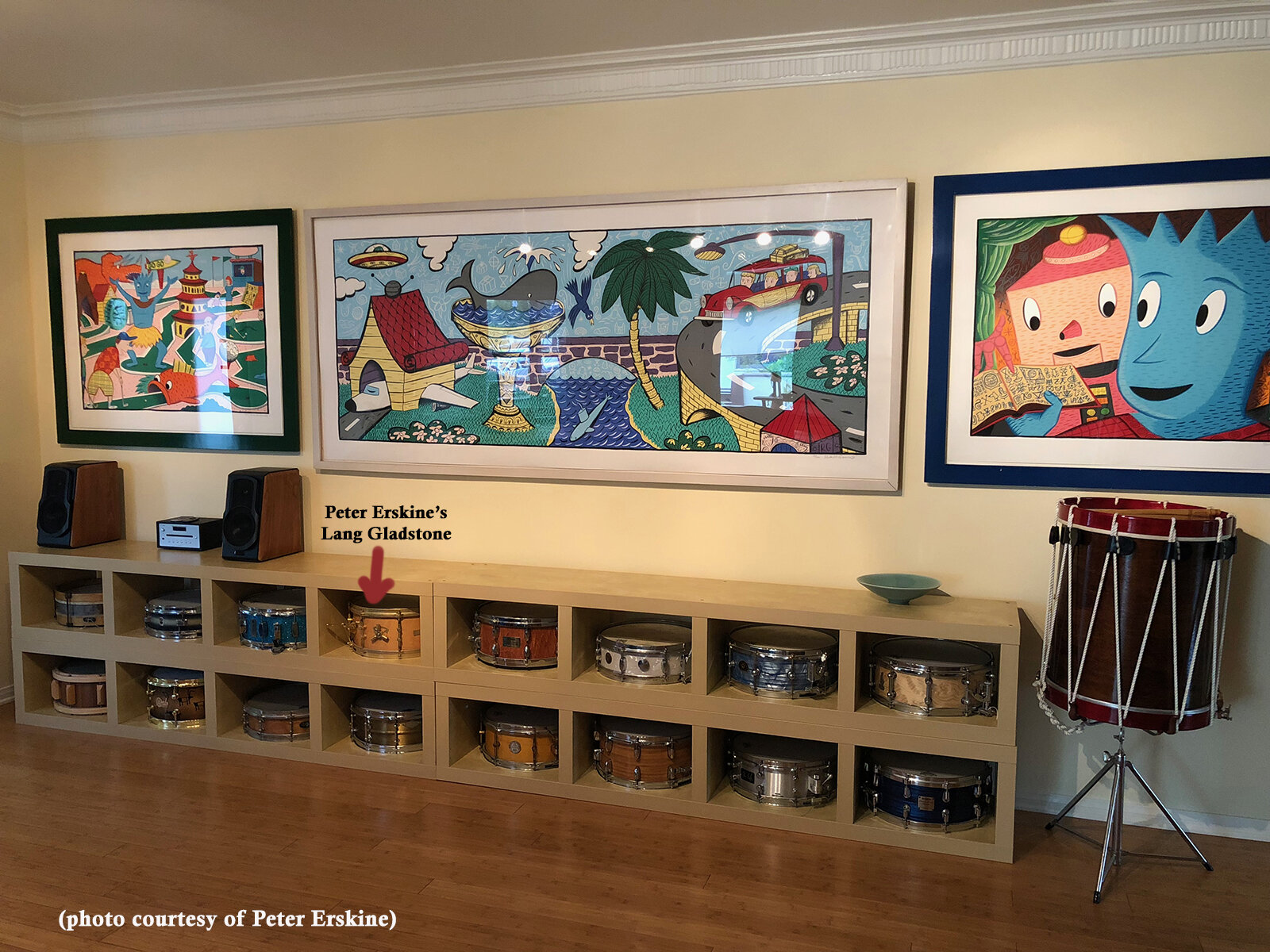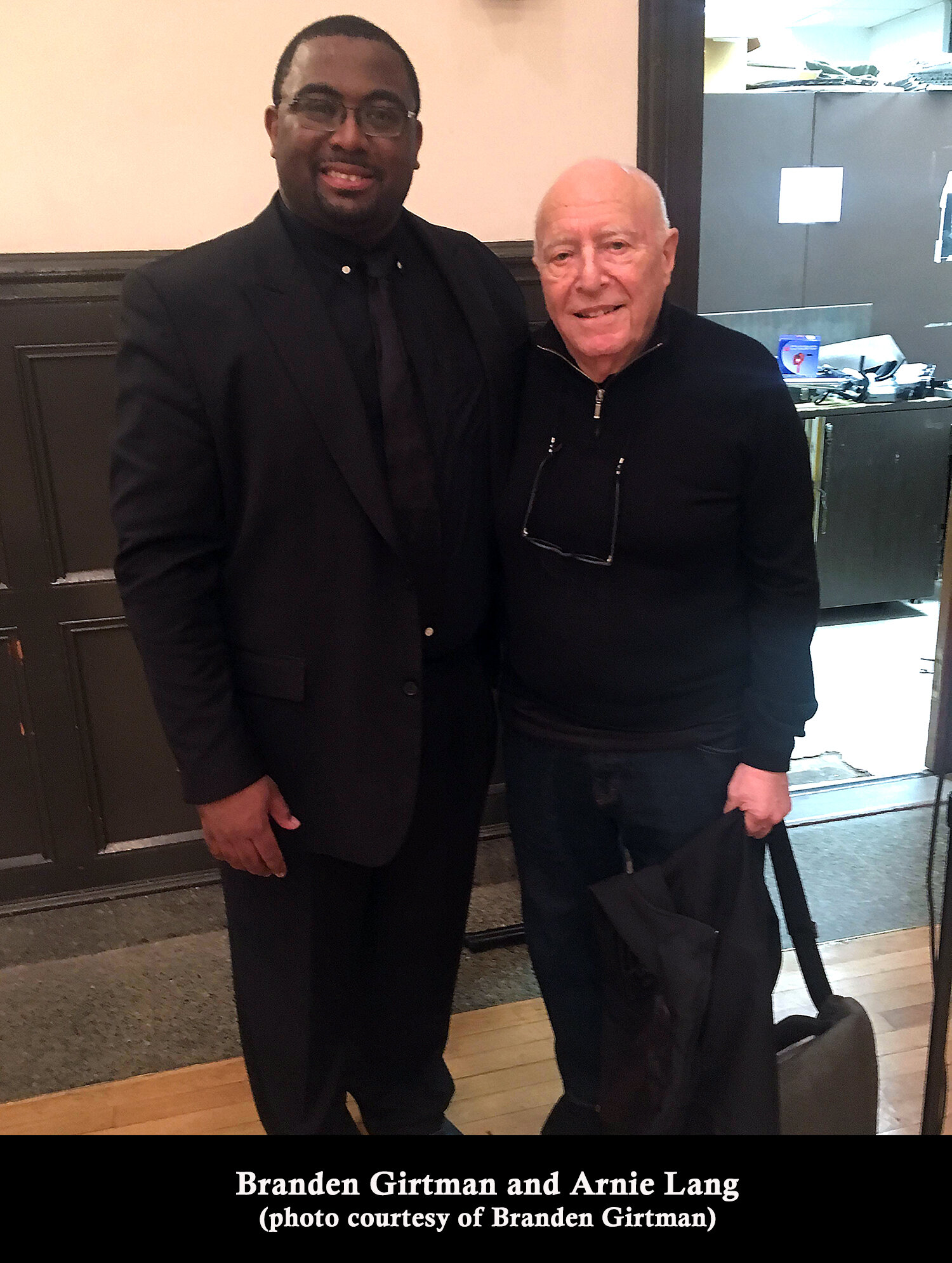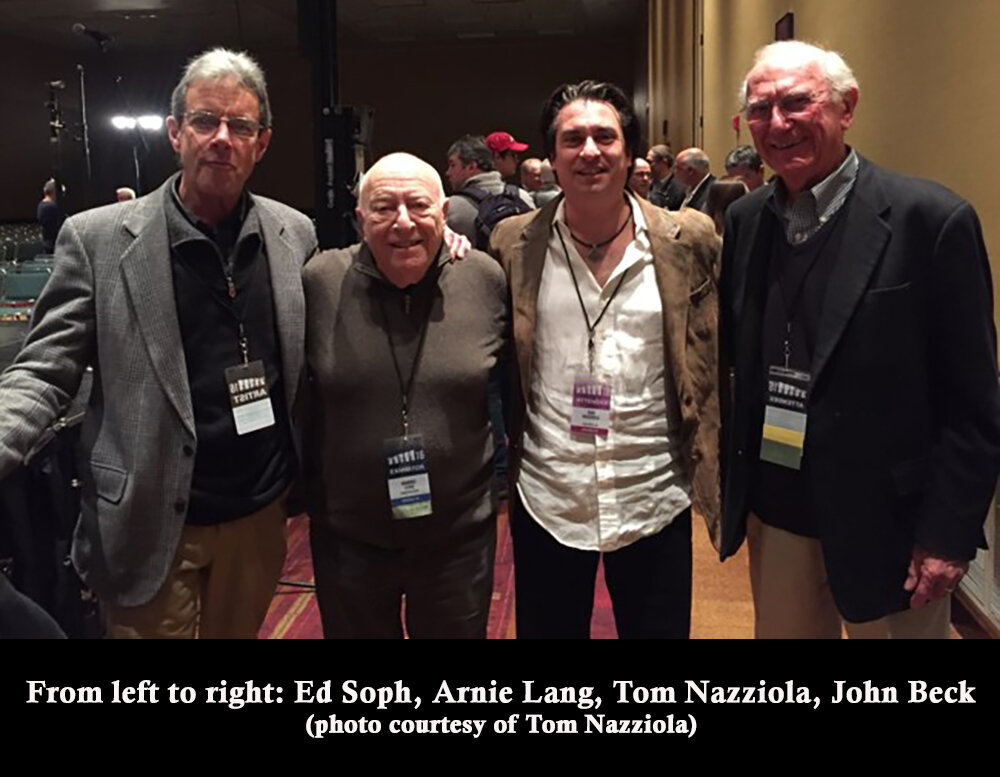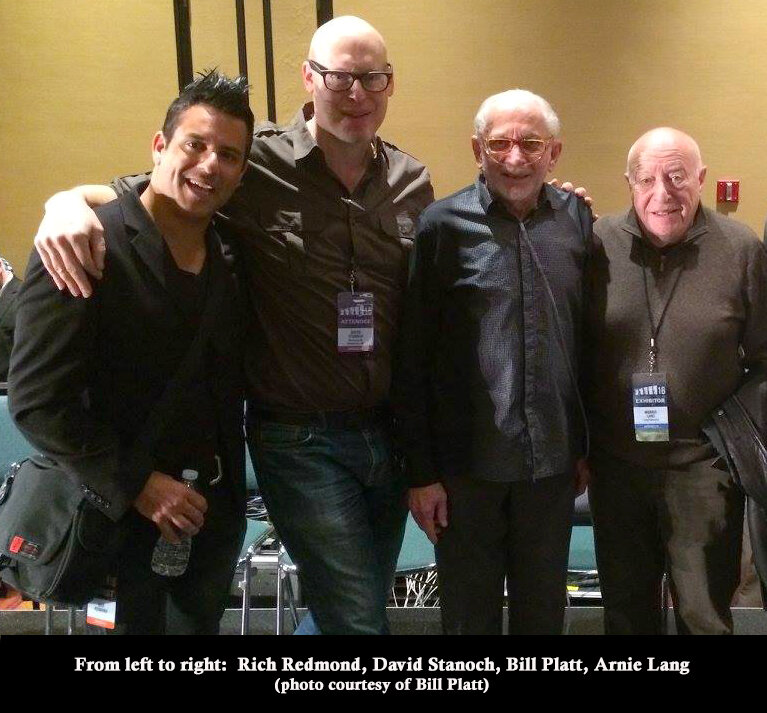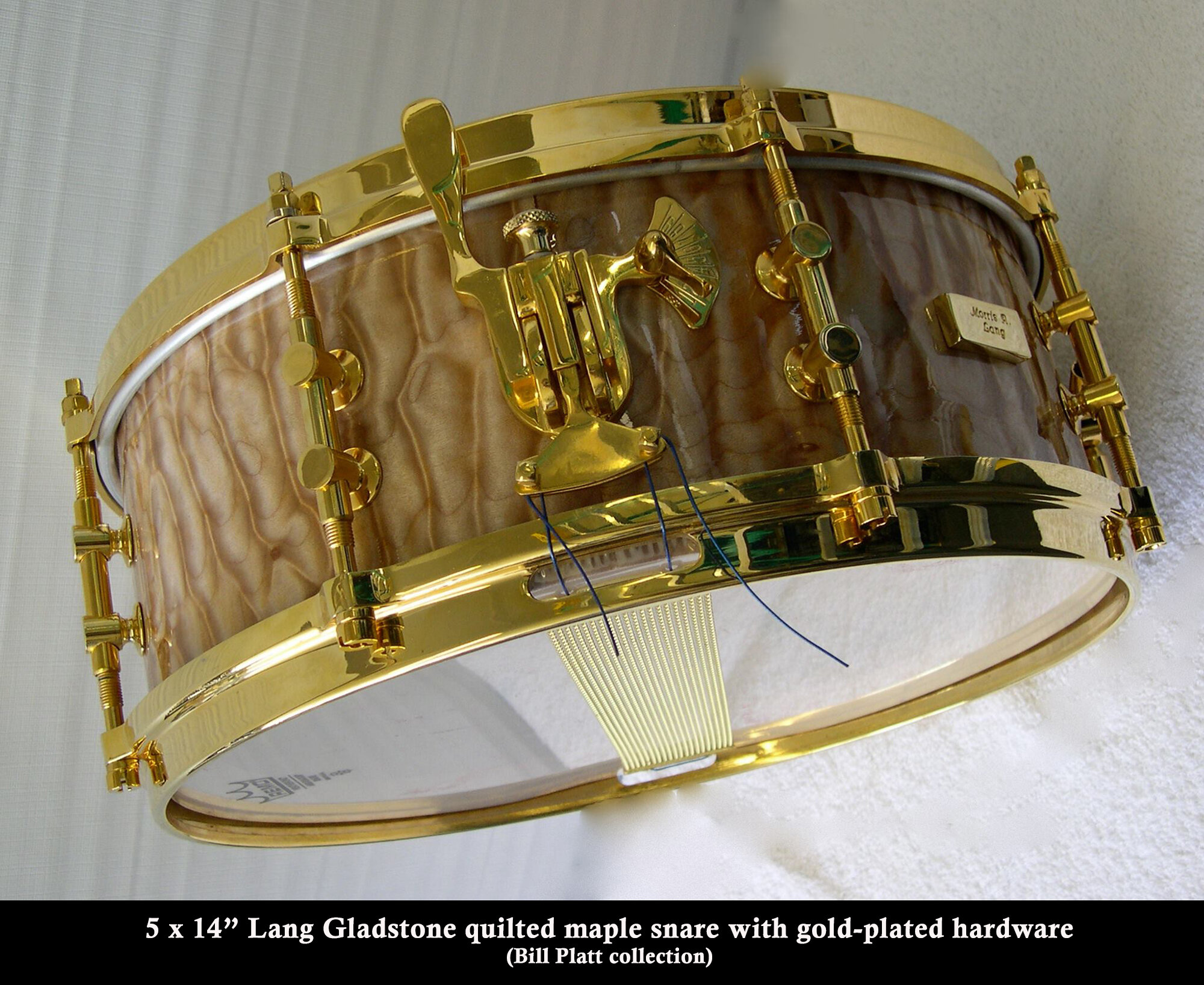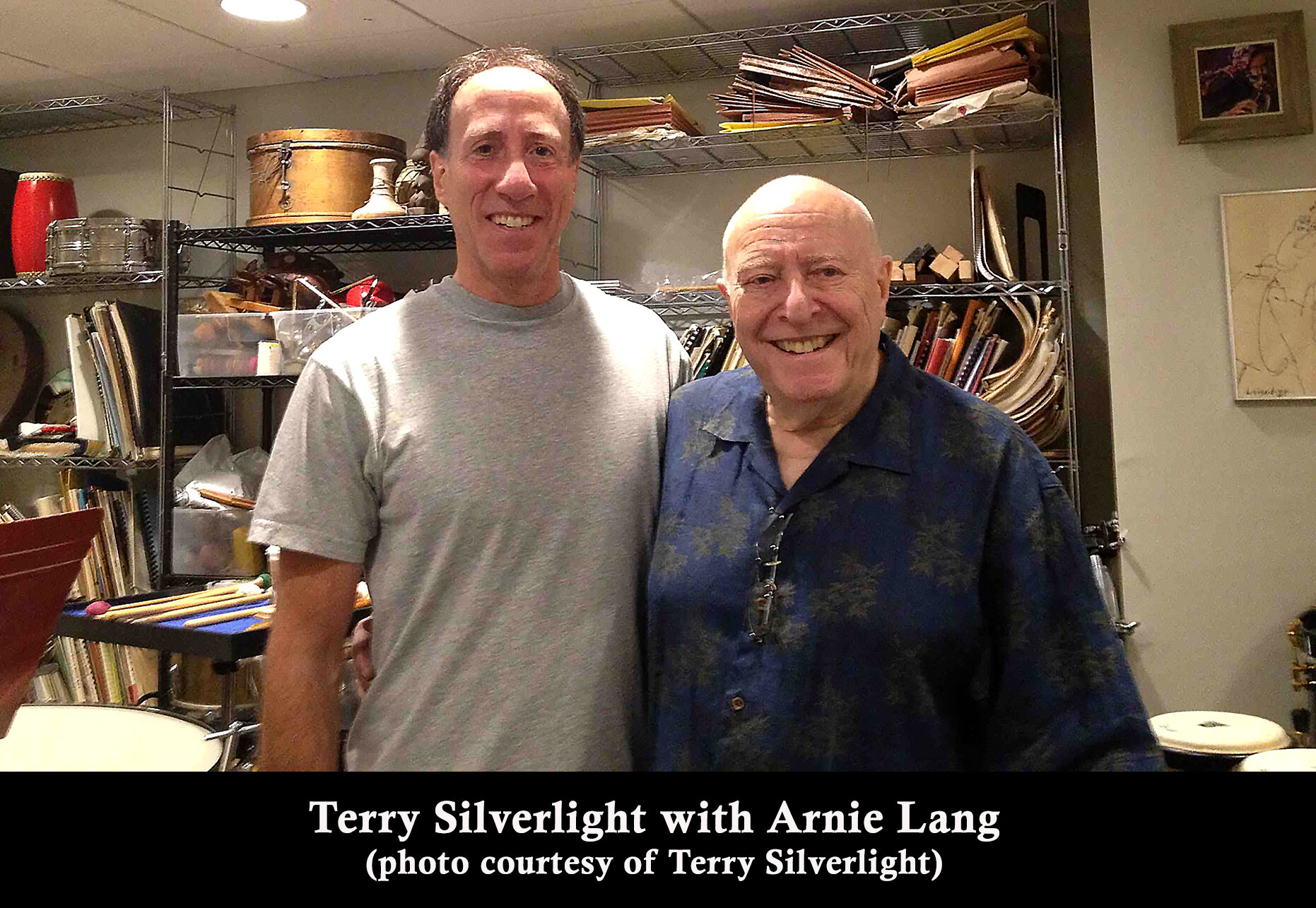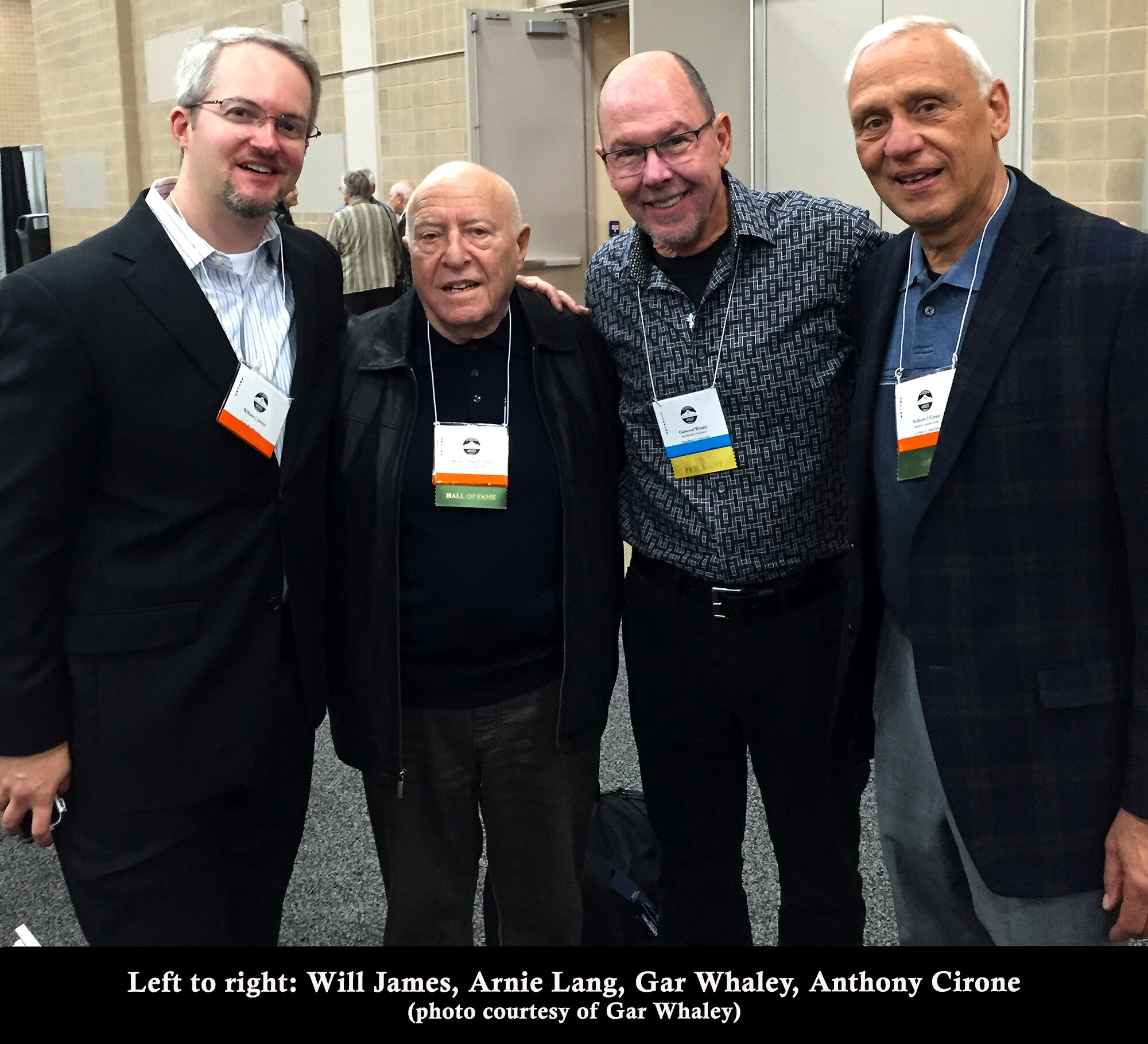By Bob Campbell
with P.A.S. Hall of Fame Bio/Tribute by Gordon Gottlieb
Morris Arnold Lang, known to his friends as “Arnie”, passed away recently following an unfortunate accident. Arnie was a talented musician, educator, prolific writer, and craftsman (Lang Percussion), devoted husband and father. In his nine decades on this planet, he gifted us with the legacy of his music, educational books/videos, many students, family, friendship, and amazingly crafted drums in the spirit of Billy Gladstone. While one always wishes for more time with such wonderful people, we are reminded how blessed we are to have lived in his presence.
For those of you who did not know Arnie Lang, I’d like to share a brief history of Arnie’s impressive career, followed by comments and anecdotes from fellow musicians and students. In this way, hopefully everyone can appreciate the amazing impact he had on this world, both personally and professionally. Please note that this article will exist on-line and should be considered a “living document”. If you have additional stories or comments about Arnie to share, please email (fallendrummer@me.com) and I will update the article periodically. Arnie touched so many lives; I am certain there are many more memories to share.
Arnie Lang was inducted as a PAS Hall of Fame member in the year 2000. To quote PAS, “The Percussive Arts Society Hall of Fame was established in 1972 and recognizes the contributions of the most highly regarded professional leaders in percussion performance, education, research, scholarship, administration, composition and the industry. Inductees demonstrate the highest ideals and professional integrity to their profession to bring about significant events, substantive improvements in the world of percussion, and the betterment of the profession through exemplary services or acts.” Arnie was that and more. It seems fitting to include the PAS Hall of Fame biography so nicely written in 2000 for this occasion by author, Gordon Gottlieb:
P.A.S. Hall of Fame Bio/Tribute (reprinted with permission):
“Arnie Lang is one of the 'youngest' people I know. Consistently living in the present, possessing a ripe sense of humor, a keen mind, an open fascination, and curiosity about so many things, a man who tells you the truth; this is the stuff you want in a best friend.
I love hanging out with Arnie. One refers to our Hall of Famer as Morris if you've never met, or once familiar, as a term of affection. Arnaldo is also good. So, the prospect of getting together to comb his past for purposes of this article was, of course, a delight, and at the same time, a bit odd. In between talking about books, movies, jazz, pop, world music, the state of the current New York Philharmonic, and a recent dentist appointment while eating Chinese dumplings and soup, we managed to journey back into an incredibly diverse career.
Arnie grew up in the Bronx, New York, surrounded by many styles of music. He found his way to the drum set, studied with Dan Shilling, and played club dates and shows in the thriving scene in the Catskill Mountains in upstate New York, an experience he claims grounded his sense of time and form to this day. A flute player friend suggested the idea of looking into Juilliard, and Arnie's mother called the school, as this was alien territory for Arnie-Charlie Parker, not Charles Ives, concerned him.
Arnie began studying at Juilliard with Morris Goldenberg while still in high school, and one day while playing duets with a fellow student in the hallway, Saul Goodman stepped out of his neighboring room, stood over Arnie, asked who he was, with whom he was studying, and summarily informed him that from the following week forward, Arnie would be studying with him. Thus began a career-making, lifelong relationship.
During his time as a full-time student at Juilliard, Arnie also studied with Billy Gladstone (who'd also loom large in Arnie's career), the infamous instrument inventor and snare drummer at Radio City Music Hall. Arnie's free-lancing at this time included Radio City Music Hall, the New York City Ballet Orchestra, the American Opera Society Orchestra, and many concerts. Eventually he started playing extra percussion with the New York Philharmonic.
There are always great stories about being in the right place at the right time, and serendipity and karma, or just plain luck. But with Arnie, all of the above run together like an art form. Talent and intelligence obviously play a part as well. In the summer of 1955, Arnie's ex-wife was performing in summer stock in New Jersey, and anticipating a quiet summer, he offered to babysit their child. So, he left his New York apartment (and telephone) behind.
He sent a postcard to Saul Goodman that included his New Jersey phone number, and at the same time took a two-week gig in Washington, D.C., playing Menotti's 'The Saint of Bleecker Street,' an opera he'd already played on Broadway. Meanwhile, Goodman had been trying to contact Arnie about joining the New York Philharmonic on a tour (for which he was too late), and more important, about getting himself back to New York to see the manager of the Philharmonic.
Assuming that this was about auditioning for the orchestra, Arnie began to practice heavily, got back to New York with his case of sticks, and met with the manager, who promptly offered him the position! The 25-year-old was given five dollars over scale and a thirty-week season.
Goodman told Arnie that he was to be assistant timpanist and play primarily cymbals. Arnie had literally never played cymbals. He mentioned this to Goodman, as well as the fact that he owned only a pair of 14-inch hi-hats and a 16- or 18-inch crash/ride. It was clearly time to shop-and learn. He bought some cymbals from his New York Philharmonic predecessor, Art Layfield, went to the Zildjian factory, and started to develop a cymbal collection.
Scene: Arnie's first concert with the New York Philharmonic. Conductor: the legendary Dimitri Mitropoulis, owner of a legendary delayed beat. Music: 'The Star-Spangled Banner'-which at this performance featured Arnie in a Bela Lugosi-style set of tails, and a rousing finish to the anthem that went something like this: '...and the home, of the-CRASH!!! - brave.' Things went much better with De Falla's 'The Three-Cornered Hat.'
And so, Arnie's 'teachers' were now Mitropoulis and Leonard Bernstein (who were sharing musical directorship), Saul Goodman, and the other members of the New York Philharmonic percussion section: Walter Rosenberger and Elden 'Buster' Bailey. Lucky guy! Playing inside a section with an impeccable time sense, a collective artistry that was so natural, and a standard that was day-to-day so high, Arnie says now, in retrospect, that he almost took this utopia for granted.
In terms of cymbals, Arnie credits Leopold Stokowski, frequent guest conductor with the New York Philharmonic, with opening his ears and imagination. 'Stoki' offered creative similes, metaphors, and adjectives to describe the sounds he wanted, and Arnie had to practice and find the right sizes, thicknesses, and timbres suggested by the maestro's comments.
For forty years (1955-95), Arnie was part of the New York Philharmonic. He cites Leonard Bernstein as 'the best,' with experiences such as Mahler's 'Second Symphony' with Lenny (Bernstein liked to be addressed informally) positively life-changing. (I can certainly attest to that!) He also enjoyed working with Pierre Boulez, Stokowski, Mitropoulis, and Zubin Mehta. Some favorite tours were a ten-week European tour that included a three-week excursion in Russia (when he was 28), an eight-week tour of South America that included some memorable outdoor concerts in Brazil, and tours of Asia in 1979 and 1984. (We studied tabla together in New Delhi on the '84 tour.)
There are numerous other chapters in the Lang story. As a teacher, he's been associated with the Manhattan School of Music, the New York College of Music, and Kingsborough Community College. His longest association began in 1971 with a chance encounter with his high school band teacher, Abraham Klotzman, after a Philharmonic concert. Klotzman introduced himself and his wife, Dorothy, who immediately offered Arnie a teaching position at Brooklyn College. She was chairperson of the music department. He started a percussion department from scratch, with only the orchestra's four timpani, an old snare drum, and a xylophone with which to work.
Well-he's still teaching there, lots of shopping has taken place since, the percussion ensemble has done four international tours (they were in Ireland this past June), and there have been several high-profile graduates from the program. Note: Arnie served as Professor of Percussion at the Conservatory at Brooklyn College until 2005. He taught at the Graduate Center of CUNY as an Adjunct Professor for 2007-2018. He also served as Professor of Percussion at Lehman College in NYC.
At one ensemble concert in Tully Hall, Arnie performed four of the 'Eight Pieces for Kettledrums' of Elliot Carter. After the concert he was approached and asked to record the pieces for Columbia (Sony). One month before the recording, Carter requested that all eight be recorded, so Arnie had a quick month to prepare the remaining four.
Carter has figured throughout Arnie's career. While still a student of Saul Goodman, during a lesson Goodman gave him the then-titled 'Six Pieces for Kettledrums.' Some years later at a contemporary music concert organized by New York Philharmonic players, Arnie performed the 'Recitative' (which is dedicated to Arnie) and 'Improvisation' (only the second performance ever). And Arnie has participated in recordings of Carter's 'Double Concerto' (premiere recording), 'Concerto for Orchestra,' and 'A Symphony for Three Orchestras.'
Then there's Lang the creative entrepreneur, who has the uncanny ability to fill voids. For example, around 1976, he took the fresh manuscript of a self-written snare drum book to a mega-publishing company and was asked to scale back his concept, he left the offices and found himself walking down one of New York's larger streets, where he happened upon a store that sold printing presses. He went in, asked how a press works, bought a press, and started the Lang Publishing Company, to not only disseminate his own material, but also compositions by friends. Currently, Arnie has eight books on the market, including the seminal Dictionary of Percussion Terms written with Larry Spivack, the ingenious Timpani Tuning, The New Conception for Drums – The contemporary approach to Jazz drumming (a pivotal book for drum set that was one of the first to codify the notation in use today), 14 Etudes For Mallet Instruments (style studies), and 15 Bach Inventions (transcribed for mallet instruments in duet form). There are some thirty contemporary compositions now distributed by Plymouth Music.
2021 Update: released the following after this biography was written:
- (2021) “Practicing Music – how the professionals do it” by Brian Willson and Morris Arnie Lang
- (2020) “A New Conception: Using changing meter to enhance your drum solos (in swing, fusion and latin styles)” By Morris Lang and Terry Silverlight
- (Circa 2014) Several instructional videos with Hudson Music: “Gladstone Pack 1”, “Gladstone Pack 2”, and “The Gladstone Technique”
In the 1970s, cane- and rattan-handled mallets became a scarcity, so after seeing a classified ad for cane and rattan, Arnie bought a truckload, had it dumped in his basement, and proceeded to make sure that his students and the rest of the percussion community had such mallets available. (The xylophone-mallet molds were eventually sold to Leigh Stevens and Malletech.)
And then there is Lang Percussion, which maintains improvements upon, and construction of, Goodman timpani (Goodman and Arnie had set up a partnership to do this) and Gladstone snare drums. Arnie has extended the latter to include drum sets, all with the classic Gladstone look and three-way tuning.
With all these lives, Arnie also enjoys holding his wife Elizabeth's hand and jumping up and down at a Rolling Stones concert; finding incredible restaurants; attending plays, movies, and concerts; spending time with his grandchildren; and being so eternally fresh and present.”
About the Author: Gordon Gottlieb has had a varied career that has included performing with the N.Y. Philharmonic and Stevie Wonder, recording with Michael Jackson and Steely Dan, playing with an escola de samba in the Carnival parade in Rio de Janeiro, recording Stravinsky’s “Histoire du Soldat” and “Les Noces” with Robert Craft, and teaching at Julliard and Yale.
Shared Thoughts & Memories of Morris Arnie Lang:
Annette A. Aguilar: Today is a different day. The folks upstairs took a serious Angel – Morris Arnold Lang. Arnie, as I started to call him when I was blessed to work aside him teaching our percussion students at Celia Cruz Bronx's High school of Music. I was already at Celia. However, Lehman CUNY in the BX where I received a second Master's in Music Education did a great move by having Arnie teach percussion there. This was a good ticket across the board for everyone at the college and the High School.
Arnie was like no other in his generation. He was ahead of the "Groove". He was open like a BeBopper which I would refer to him. The coolest and hippest classical percussionist of his era. Even folks of the same genre who were 20 years or 30 years younger were not as open and hip like Arnie; there was no comparison. You could tell how hip Arnie was in the way he dressed - pretty slick. Arnie would come to some percussion activities I was doing at Lehman and even pushed for me to do a Clinic when the Irish students came to town. I always push my students about the importance of Orchestral Percussion and Arnie.
I had some recent conversations with Arnie this past Pandemic year since I was moving to a different direction in education. He admired me for being creative and keeping my group going as well as staying in the Orchestral field and keeping my chops up. We would have conversations about how he would schlep his chain tymps in the car to different gigs. Of course, that changed after he got the Phil gig that lasted 40 years.
He was like an everlasting light in the Percussion world, not just in Orchestral Percussion but in all genres. I thought he would be here forever, but he will always be with all of us that he touched. This is the kind of soul he had. Arnie R.I.P. So sorry we never did that Tymp piece together. Thank you for everything. Love you always.
Joe Bergamini: I first met Arnie at KOSA, where I was also teaching. He was friendly and approachable and had such a youthful vibe and easy class to his personality. I immediately liked him, even though I must admit I was unaware of the full breadth of his experience, resume, and wisdom. Over the years, we met and hung at various industry events, and then spent a lot of time together planning and filming his Gladstone Technique DVD for Hudson Music. I was also able to invite him to be a speaker at a couple Sabian Education Events in New York. Arnie was a giant in the world of percussion, not only for his performances with the New York Philharmonic but also for his keeping of the tradition of drum technique he learned from Billy Gladstone and the craftsmanship he put into the beautiful snare drums he built from Billy's designs. But above all, Arnie personified the word "gentleman." He was all class and grace, a kind and gentle yet hip New Yorker who I thoroughly enjoyed being with. In all the time I knew him, he always seemed so young at heart, and never lost his passion for life or music. It was an honor to be his friend.
Joseph Bonville: I first met Morris Arnold Lang sometime in the late 1970’s, when I was finishing up at college and playing in the Albany Symphony Orchestra. He had discovered an original copy of the percussion part to “L’Histoire du Soldat” and had done some editing to it. The piece was being performed at my school and Arnie came up for the show.
Having a copy of his percussion dictionary on hand I introduced myself to the handsome, wavy-haired mustached star of the New York Philharmonic Percussion Section and got his autograph on the book. We talked for a bit and enjoyed the performance of L’Histoire together.
Fast forward around thirty-five years. I am walking the exhibition hall at PASIC, and at the far end of the row, I see a bald man walking right towards me. I know that this is Arnie Lang, and I want to reintroduce myself after all these years. To my surprise, he walks up to me and says, “I know you. You played in the Albany Symphony.” Anyone who didn’t know Arnie would have a hard time believing that story. Thirty-five years? He has lost his hair and mine is gray? One of the world’s premier percussionists and a small-town drummer? Yup. That was Arnie.
I had retired from 33 years of school teaching and was able to take lessons with him. Those hours were among my most precious ever spent on earth. Besides the lessons, we would sometimes have time to stop for coffee or hop the subway to Brooklyn for his shop. I could hardly keep up with this man who was already in his late eighties!
I could write pages on my lessons, especially the stories he would talk about his days with the Philharmonic. These were priceless. It was an honor and privilege to see him pick up a pair of cymbals, see his suspended cymbal “tricks,” watch him demonstrate Billy Gladstone snare drum technique, and of course, the teachings of Saul Goodman. The consummate teacher and percussionist that everyone knows.
But that was not the only side to Arnie. After getting home from one of my train rides to the city my wife asked me, “So, what did you learn today?” A bunch of percussion things went through my mind, but my answer was, “I learned that an 89-year-old man can still say, ‘I love you, wifey’ when he hangs up the phone. Anyone who knew Arnie wouldn’t have a hard time believing that, either.
Kristin Brunaes: I was just 18 years old. It was the summer of 1988. I had just graduated high school and was ready to start my new life…as a “big fish in a little pond…or a little fish in a big pond” as my high school music teacher, Paul Tooker, had laid it out for me at the time. But that, is a whole other story…
I was standing on the corner of Wall Street and Broadway with my then boyfriend…who then told me to grab a pay phone and call my mom. You see, he lived in Manhattan…and NYC living was so very new to me. She called his dad to tell me that I received my letter from the Brooklyn College Conservatory of Music and to call home right away.
I grabbed the nearest dirty street phone booth that stank like NYC street urine and called her back and made her read that letter over the phone to me. Not only had I got accepted into the conservatory, but Morris Arnie Lang had also chosen me as a private student. Yes, this half punk/half rock and roll girl from the streets of Staten Island and Brooklyn had been hand-chosen to study as one of the youngest students ever to study with one of the principles of the New York Philharmonic.
There wasn’t a feeling in the world that could describe what I felt at that very moment…except sheer elation. I let out a toe-curling scream that echoed throughout the Canyon of Heroes that would wake the dead at Trinity Church.
Having just found out that my mentor and friend just passed away yesterday makes me truly sad. I studied and took my private lessons with him at his home loft…spent hours with him and the percussion ensemble in rehearsals…learned crazy John Cage charts that I had to read in circles, played till my fingers and hands bled, was recommended by him personally to study with Saul Goodman. His ability to see my talent was truly remarkable, even when my own self-esteem was truly in the toilet.
I was so glad that we spoke and reconnected when my son started at Louis Armstrong Middle School and found out that my son was playing too. He was thrilled.
And yes, I still have the practice xylophone that he gave me because I couldn’t afford my own. I will treasure it forever. Thank you, Arnie…you simply changed my life. I will truly miss you…thank you for making me one of your “little fish.”
Bob Campbell: I’ve had the privilege to chat with Arnie off and on for the last 20 years, mostly about his drums, the incomparable Lang Gladstones, and had many wonderful conversations with him at PASIC. Arnie was always a true gentleman in every sense of the word. He treated all with respect and kindness. He loved to share his knowledge of drums and drumming. The very first time I contacted him for an interview many years ago, he wrote back in true Arnie fashion saying, “Hi Bob. What kind of information are you interested in? Size of my waistline (you don’t want to know), etc…” I laughed pretty hard at that one. He could be serious at times but always had a charming sense of humor.
For the last couple of months, I had been trying to nail him down for an interview about his new book. He was so excited and energized. Here is an excerpt from one of last emails: “Bob, I have been pre-occupied with a couple of projects, and I have even been going into the shop a few days a week. Don't know if you have seen the new "Practicing Music- How the Professionals Do It" recently published by Meredith Music. It took a couple of years to get it together, but I am thrilled with the results. Don't know if you know of Brian Willson, an ex-student, great drummer, and collaborator on the book. It would be really great to have a review in Percussive Notes and Not So Modern Drummer magazine, (and of course hear your opinion on the book).” We weren’t finding a time that worked for a live interview so I asked him if he could email me a few details about himself and the book. He said yes but didn’t get the time to follow up. Unfortunately, that was our last email correspondence. I am deeply saddened that we will never have that conversation.
I’ve now owned 4 Lang Gladstone snare drums with shells made out of Timeless Timber maple (Craviotto), oak, cherry and even titanium (Dunnett). All fabulous sounding drums. They serve as reminders to Arnie’s craftsmanship and dedication to the instrument.
Kat Casale: Last week, the world lost a maverick. I started an apprenticeship with Arnie in 2012, young and searching for my purpose amid a lot of post grad confusion and wound up working for him for 7 years. I owe Arnie so much for all the knowledge and insight he's shared with me over the years.
Those years we spent tinkering away in the shop and talking about music, time, New York, things that in the moment seemed to hold no real significance, now feels like an irreplaceable loss. But in those conversations one of the more valuable gifts Arnie taught me was the value of perspective. To listen; look; feel up close, but also from across the room, and then again from the other side of the world.
The framed picture in the first photo has been hanging on the wall in the shop since I have known Arnie. It's of Arnie in 1959 playing as a trio in Moscow on tour with the Philharmonic under direction of Leonard Bernstein. On Tuesday as I helped Arnie's wife, Elizabeth, and son David make sense of all of the things in the shop, we came across the unframed photo in a drawer overflowing with a lifetime's worth of notes and photos. The feeling of seeing a friend, a mentor, after they've gone is indescribable. To share that feeling with the people who knew him best is a new gift that Arnie is giving to me.
My heart will feel conflicted every time I reach for the phone to call my friend just to chat. His legacy so vibrant that it casts the illusion that he's still with us. If you have a story about Arnie, share it. If you had never met him before, learn as much as you can about him. Time can be cruel to memory, but Arnie, with all of his friendships and accomplishments, is just too important to allow those effects to set in.
I will try my hardest to honor and do justice to his legacy with the gift that brought us together in the first place. The gift of music.
David Deej DiGiantomasso: This man was a giant in the classical music world, and also in music education. He was one of the great NY philharmonic percussionists for decades.
When I first came to NY and was living hand to mouth in Brooklyn, I was working all kinds of odd jobs so I could stay afloat. One night in February, it was cold and snowing. I was out going door-to-door asking for donations for my job as a canvasser. It was the worst odd job! I decided, “NO more! I’m going to work in my industry of music.” I went home that night chanted/prayed. The next morning, I did the same and opened up the yellow pages (remember them?) to Lang Percussion. So, I called for a job. Ring, ring- “Hello, my name is David and I’m looking for work in my field of music, not sure if you’re hiring but I’m ready and available for work.” Not knowing me, Arnie Lang said, “OK - come down and let me meet you.”
I went down not knowing my life would open up from this point, and I would never look back. I was hired on spot. I learned to make some of the best snare drums in the world. I got to also study with Arnie. I had the keys to his practice studio, and he even let me sit in on his Brooklyn College percussion classes. Most of all, this time gave me the confidence it takes to make it to the next level. Thank you, Arnie, for your work here on the planet! You are l oved by many because of who you are! You have made a difference in my life, and I thank you!”
Bill Donnelly: Saddened to learn of the passing of Morris Arnie Lang. I first met him when I was a 14-year-old, long haired little rock kid. Morris was performing with the NY Philharmonic, and having read about Arnie in Modern Drummer, I snuck backstage to see him. I thought he would shoo me away. Instead, we talked and then he said, "Follow me."
We went to a trap case, and Arnie began pulling out different instruments. He introduced me to Buster Bailey, and Zubin Mehta walked by saying "It is hot as hell today!"
Arnie invited me to study with him at Brooklyn College. I never went there, but always wanted to get a lesson. I finally did in 2017. As a student of Billy Gladstone, he was a link and a torch bearer for the legacy and history of American drumming. He shared his understanding of the technique, but only with concern for the music first. I was a beginner again that day and loved it.
Morris was truly a gentleman and a scholar. He was soft spoken, eloquent, and classy - always with integrity. Morris played under the baton of many famous conductors but retired when one failed to understand the importance of percussion in the orchestra. He walked the walk.
We lost someone who made incredible symphonic music, was a teacher, mentor, and friend to many, and demonstrated how to live the life of a musician. RIP, Arnie, and thank you.
Ronn Dunnett: I knew Arnie for a long time. He was just a sweetheart of a guy. He was such a beautiful old soul. We met around 1999. At one point, I approached him and said, “Hey, why don’t we do a titanium Gladstone?” So, we did. I still have images from 2001 of a prototype titanium Gladstone with my name on it. To date, we made less than 10 titanium Lang Gladstones, so they are rare and precious. Working with Arnie, in retrospect, I count as one of the jewels in the crown of my career. We owe Arnie a debt of gratitude for the work he did to continue the legacy of Billy Gladstone. For him, it was a labor of love.
Arnie was one of those guys where, if you were in the room with him, the best thing you could do is shut up and listen. He had so much to offer and had so many great stories. He was such a talented percussionist. When he spoke about his career, he was humble but yet you could tell how proud he was of accomplishments. Musically, he had done so much and earned his place in the symphonic percussion history book. The world was better with Arnie in it.
Peter Erskine: So sad to learn of the passing of Morris “Arnie” Lang. Condolences to his wife Elizabeth and to all of his friends, colleagues, and students. This is truly the end of an era.
I’ve attached a photo … Jaco, me and Arnie in 1978 when Weather Report ran into the NY Phil. on their tour of Japan … this was in Osaka. Jaco was playing Arnie the opening vamp of his new composition, “John & Mary”. I felt lucky to be there, hearing the piece for the first time. Arnie pulled me aside and said, “Geez, this guy’s never listened to Aaron Copland, huh?”
I was fortunate enough to purchase a Gladstone snare from Arnie, a beautiful maple instrument with gold-plated hardware. I used this drum on the ECM album, “Time Being”, as well as the double percussion concerto, “Fractured Lines,” composed by Mark-Anthony Turnage and performed by the BBC Symphony Orchestra, Evelyn Glennie, and myself. Ever since the 1960s when my father first heard about the fabled Gladstone snare drum, finding a Gladstone became an Erskine quest. I first laid eyes on one when I met Ted Reed in Florida, but it took Larry Bunker showing me (and letting me play) the late Shelly Manne’s personal Gladstone snare (#2, I believe) that really hooked me (back in the late 1980s) … so, Arnie helped make one of my dreams come true.
It was also a pleasure, or shall I say, it was never a complete Percussive Arts Society conference unless and until I ran into Arnie and we shared a coffee and a chat, which always included *another* great NY Phil. story about either Lenny or Buster or both. I miss him already.
Arnie was a cool guy. Funny. A great percussionist. Wonderful instrument maker. Teacher. An example for so many years of that place where artistry meets professionalism.
Thank you, Arnie.
Thank you.
Rest In Peace.
Chet Falzerano: My experience with Arnie was one of a student of history. Without his help, my book “Billy Gladstone” would not have been published. We spent countless hours together with him graciously telling me his experiences with Billy Gladstone (of course it occurred to me that I was talking to a master, recanting stories about a master). Many claimed to be students of Gladstone, but by my account, Arnie the most prolonged. It began at Radio City Music Hall, “During one of the breaks between shows we all went downstairs to the employee lounge where there was an adjoining practice room. That’s when I met Billy; Harold (Farberman) introduced me to him. Billy asked, ‘You want to play a little bit’? So, we all started exercising on practice pads. Billy came over to me and pointed at my right hand saying, ‘You get pain in this area, right around here, right’? I was taken by surprise because it was true. ‘You also experience pain in this part of your left wrist’, pointing to the exact spot that I was having trouble. I said, ‘Yeah, do you give lessons’? and within a short time I was taking my first lesson in his apartment on 54th Street and 6th Avenue. We never worked off of sheet music during any of my lessons. I was, after all, studying with Saul Goodman and Moe Goldenberg, so I did not need coaching in theory. No, our work was strictly conceptual...proper grip, natural hand positioning, controlling rebounds, relaxed approach, producing tones, that kind of thing. I was so happy to lose the tension and therefore the pain in my hands. Billy was a nice addition, coaching wise, to Goodman and Goldberg'.” What a legacy!
Branden Girtman: Professor Morris Arnold Lang was my private music instructor at Lehman College from 2015-2018. He was full of life and gave it his all in everything he did. He was a member of the New York Philharmonic for over 40 years, but he was HUMBLE. He never bragged and was never arrogant about what he did. He was able, ready, and willing to teach everyone. My private lessons were supposed to be for one hour, but the drum lesson turned into him giving me wisdom, history, and life lessons to live by. The hour lesson would turn into 2 and a half hour lessons. I would sit there and ask question and listen to him talk. He gave me so much wisdom. He gave me books to keep and read and told me to “build my library”. He told me to make a “to-do list” every day of things I needed to do and make sure they get done and I do that to this day. He taught me how to play timpani and marimba.
He was honest, caring, loving, and we became family. Thank you, Professor Lang, for all you did for me. After every lesson I would say thank you and you would say, “It’s a joy teaching you.” You were patient, phenomenal, and graceful in everything you did. You were a gift from God to me, and I appreciate all you have deposited on the inside of me. You uplifted everyone you contacted. You were one of the biggest givers I know. You gave away the knowledge that you had, and for that, all loved you. I will miss your smile and your saying, “That’s it!” lol. You had such a youthful spirit about you. You still had plans to do more which probably included to make more drums. You will forever be remembered. Your life is a testament to how people should live. Thank you and I love you. You took your rest from this life and now God will reward you in the next.
Judith M. Hirschman: I studied with Arnie at Brooklyn College for my masters back in the 90s. I had very low confidence in my playing and had technical problems that I thought were unfixable. He not only gave me a better perspective on my playing and fixed my technical issues. More importantly (and I think this is Arnie's true legacy), he taught " the whole person" and in many ways, changed the direction of my life. In addition to making me a better performer, I resolved to give back by resolving to teach my own students with the same humility, grace, and down to earth manner as Arnie.
An “Arnie story” - I was really bummed about a gig where I thought I couldn't place anything correctly, and Arnie mentioned that I was beating myself up for something that was probably the conductor's fault. He then told me about this Tchaik 4 rehearsal with Walter, Bernstein conducting. Bernstein had a tendency just to "groove ", raising his baton and shaking it around. He then went ballistic, yelling at Arnie and Walter " "Bass drum is early, Arnie, you're late!"
The orchestra was scandalized when Arnie replied, "We could do much better if we had a down beat". Bernstein stormed off the podium for 10 minutes, then returned, giving a textbook prep, and conducting pattern. I always loved the way Arnie always called it the way he saw it, etiquette be damned.
Steve Maxwell: My longtime friend, Arnie Lang, passed away on July 5th. Arnie was almost 90 years old, but you would never have known that if you were in his presence. His energy and love of drums was inspirational and defied his age. He was more energetic than a lot of 20-year-olds.
Arnie was a member of the NY Philharmonic for decades, and those of us in the drum world remember him for his dedication to the great Billy Gladstone. Arnie acquired a Gladstone from Billy and always treasured it, so much so that he spent decades creating superb replicas of Billy's wonderful instruments. I worked with Arnie on many "Gladstone" projects over the years and we always had fun doing them. He never tired of his love for drums and the Gladstone legacy that he helped preserve.
Billy Gladstone's legacy basically fell to two people: Chet Falzerano dedicated much of his life to documenting Billy and his work and owns many of Billy's original drums. Arnie was the person who kept the Gladstone legacy top-of-mind for modern day drummers. If not for Arnie's superb replicas, many drummers would never have heard the Gladstone name, or ever been able to experience the incredible innovations that he created. I'm thankful to them both and have tried my best to support the Gladstone legacy as well, and always will. I've have had the privilege of selling many original Gladstone drums and can tell you that I have always relied heavily on the expertise and knowledge of Arnie and Chet.
Arnie is gone, so now it falls to us to help preserve his legacy. Thankfully, he willingly shared his knowledge with us so that we can continue to pass it on to future generations. I know that I will certainly be proud to do my part to preserve the legacy of my friend, Arnie Lang.
Tom Nazziola: I’m sure that much of what I’ll say about Arnie has already been echoed from students, fans, music lovers, and family. While at Brooklyn College years ago doing a Master’s degree in composition, Arnie was still part of the percussion program. I wasn’t going to pass up a chance to play in his percussion ensemble as well as take a few lessons.
This man was always about the music and always about the hang (as we percussionists like to say). I could always call him every 5 months or so and meet for breakfast...we would just talk about whatever came up. He encouraged my early percussion compositions and was always available for advice about navigating through the music scene. In fact, when meeting up with him at Percussive Arts Society, I’d always sit next to him during performances of new pieces to get the “Lang” barometer. He was tough....not easily impressed by new music. Arnie gave it to you straight, which is something I always liked about him. And you knew it meant something if he liked your music. While I know we’ll all miss this percussion icon and his many contributions to the world of music, what I’ll miss most is seeing him in a local restaurant for breakfast and hearing his warm greeting, “Oh, Hi Tom!” Arnie was the best, and I’ll miss him dearly.
Bill Platt: I first met Arnie in person as a member of Alan Abel’s PAS Symphonic Emeritus section around 2010/2011. We played together about three times with that group. He played cymbals. I pretty much always played snare drum. He was one of the stalwarts of the group. That’s how I got to know Arnie. He became a really good friend. He was very, very friendly. If you first met Arnie, he would treat you like you had friends for decades. That’s just the way Arnie was…
Arnie always had great stories. One time, he told me about getting into the NY Philharmonic. He told me, “You know Bill, I never wanted to be in that orchestra. I was happy doing what I was doing, playing Broadway shows and whatever freelancing in New York. I sort of got roped into it (he laughed). Anyway, I ended up with it for 40+ years.”
Of course, I had known about his Lang Gladstone drums for a long time. A friend of mine here in Cincinnati actually owned one of the original 50 or so Billy Gladstone snares originally made for John Noonan. It had gold hardware and a birdseye maple shell. This drum had an interesting snare set-up. The individual wire snares were cut to about 13” for a 14” drum. There was a wrap of sort over the end of the snares which could be wrapped around the butt plate and strainer just like the way gut snares would be attached. The strange thing is that these snares didn’t sound like wire; they sounded like gut or cable. A very interesting sound.
Around 2015, I asked Arnie to make me a drum with snares just like that. The shell was figured solid maple, maybe quilted or curly maple, with gold-plated hardware. Man, that drum was beautiful and sounded fantastic. When he finished the drum, he contacted me and said, “Bill, you got to see this drum. It might be one of the best I’ve ever made.” He posted a picture on his Facebook page saying, “I put on adjustable wire snares at his [Bill’s] request. Exactly what I wanted.... all curly wire…snare response is perfect! this drum is fantastic! The more I play it, the more I like it!”
Dan Rosen: I only got to know Arnie in the last few years of his life, and what a privilege that was! I, too, bought one of his drums. He suggested I go with zebrawood, a wood I had never heard of. I asked him to tell me more about it. He said, "Well, I use a zebrawood snare in my studio." That was all I needed to know. If it was good enough for Arnie Lang, it was good enough for me. On the day I went to pick it up, I think he could tell that I was looking at the drum a bit too reverently, almost like a museum piece. So, he said to me, "This is a gigging drum" and let me know I should use it, not just admire it. I follow his advice but never forget that I am playing a drum made by one of world's greatest percussionists, who made it in the way invented by his teacher, another of the world's greatest drummers, Billy Gladstone.
Like the drums he made, Arnie was not confined to one corner of the musical world. He was as happy to hang out with Carl Palmer as with anyone who might appear at Lincoln Center . . . or with kids just coming up. He was great at putting people at ease. In a lesson with him, I was at first a bit uptight about maybe deviating from some pure version of the Gladstone technique. It involved moving my right hand from the snare drum to the floor tom. Sitting behind his formidable Gladstone drum set, I discovered that just flipping my wrist over was easier, and faster, than moving my entire arm. To my relief, he said, “Why not? Do what works.”
I had correspondence with Arnie from time to time and had hoped to take a timpani lesson with him next time I could come to NYC, once the coast was clear for travel. I played timpani in my youth but haven't done so in years. Alas, that will not happen. Still, I feel grateful for the time I was able to spend with him. He was a world-class musician, but even more important than that, he was a world-class human being.
Terry Silverlight: Arnie made a major impression on me in 1976, when I was nineteen years old on a leave of absence from attending Princeton University. Prior to that point, I had been playing drums in my brother Barry Miles's group and on several of his recordings, the first recorded in 1971 when I was fourteen years old which was one of the first "fusion" projects with me as one of the first drummers helping create the foundation for those who have continued developing that style of drumming. As there were few artists at the dawn of the era creating music like that, there were few drummers playing it. I was basically on my own to figure out what and how to play it, so my drumming approach was pure 14-year-old adrenaline, creative talent, instinct, desire to achieve, and self-taught technique. By the time I was nineteen, I decided to make drumming and music a lifetime career and never returned to Princeton. One of the first things I did was realize I needed to backtrack and work on my technique, so I could execute the complex playing I was doing more fluently without unnecessary physical effort. I don't recall who recommended Arnie, but I had the good fortune of him offering to give me a lesson. When I showed up, he said "Terry Silverlight! I've been following your playing and you're amazing. I don't understand why you're here." I played him a few basic single and double strokes and immediately he knew what I needed. He opened the gate for me over the course of only a dozen or so lessons, showed me how to loosen up the right way without sacrificing power and endurance.
What Arnie taught me conceptually made it possible for me to set aside technical struggles and concentrate on the creation of music itself. I think about it every time I play. In addition, I'm honored to have become friends with Arnie over the years and to get to know how amazing a person he was. He was known for always being up to date with musical happenings not only in classical music, but also in all genres (he knew of me!). He was always working performing, recording, teaching, writing, or drum manufacturing until his last day. I've heard people say as he aged "He's the youngest guy I know". Without mentioning names, his musical associations ran wide and deep in many corners of the music industry with the best musicians in the world idolizing him and acknowledging the influence he had on them, the same as I have. And in my professional career, I had the honor of co-writing with him "A New Conception" published by Bachovich; he played percussion with me on my "Duets" album; he wrote a beautiful quote for my book "The Featured Drummer"; and we performed live together on occasion.
Arnie will be dearly missed, but the musical contributions he made in many ways are part of history and will be passed along to those who follow for a long time.
Garwood Whaley: I’ve known Arnie Lang since my Juilliard days as a student in the early 60’s; he was one of my musical hero’s! I was lucky enough to publish several of his works, the latest written together with Brian Willson: Practicing Music: How the Professionals Do it. When I attended New York Philharmonic rehearsals as a student, Arnie always made me feel like I was a more of a colleague than a student. I loved seeing him every year at PASIC and remember during one convention his performance of the Bartok Sonata for Two Pianos and Percussion with my teacher Saul Goodman. What a thrill that was! Arnie was a caring, generous, and fun-loving individual who I will miss greatly.
Brian Willson: I was Arnie’s assistant at Brooklyn College for 11 years and taught with him. We were the best of friends and wrote a book together: “Practicing music, How the professionals do it”: https://www.giamusic.com/store/resource/practicing-music-book-10180
It took me while to get my thoughts together about losing our great Arnie Lang; so many have said such beautiful things about him, and every comment rang so true to me. He was one of my best friends, teacher, mentor, colleague, author, masterful musician. He was a person of incredible integrity; he did things because they were good to do.
He also had an amazing work ethic; I spoke with him the previous week; we were making dinner plans (we had not gotten together in a long time). It was 98 degrees, and he was in his drum shop, no AC. I thought, "What are you doing in the shop in this heat?" but I knew better. He was working.
I found a few photos and video ( https://youtu.be/UuG0EdCuP7I ). Maybe some people don't realize he was a terrific improvisor also. I had asked him to perform on an improvised music concert and he readily agreed. (Please forgive my corny joke up-front, and I wish the camera stayed on him the whole time). I'm missing him like crazy, but nothing was left undone. I've been honored and fortunate to have spent so much time with a person I love and revere.
Morris “Arnie” Lang – a true legend; gone but never forgotten. He lives on in the hearts and minds of all he touched, and the timeless music and instruments he created.
Many thanks to all that contributed their thoughts, stories and pictures.
More info, pics and video of Arnie Lang may be found here:
https://www.namm.org/library/oral-history/morris-lang
https://www.youtube.com/watch?v=pZ3dUYojduU

